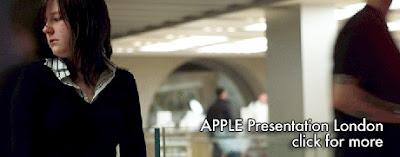
The date needs sorting but I'm going to be back at Apple Regent Street London for an evening of fun and play.
It's going to be an hour and half session with 30mins Q&A and its free for you to attend.
So what can you do in that time?
In the past I have used Apple sessions to showcase work.
This time, I'm thinking about concentrating soley on video and aggressive videojournalism, which means it'll be far more practical.
Also I'm looking to get video of my buddy, Rob Montgomery from Visual Editors showing how he uses his i-phone as a reporting tool ( We hung out in Cairo where we worked on a joint reporting project).
I'll deconstruct one of the UK's most cutting edge series I worked on as a Reporter/Assistant Producer in the 80s/90s: BBC's Reportage, which could easliy be the gene for Current.tv.

David reporting on the UK Brain Drain for network current affairs youth programme BBC Reportage.
Click below for show
The programme invested in a style which in now all but redundant, but as I'll show it was right on the money in the way it mixed genres and could be invaluable for big set piece video programmes. e.g the Telegraph for instance, which is planning a major series on politics.
Several of its original casts are huge names in the industry.
Apple Time after session
Hopefully they'll also be time for looking at multi-entry story telling, so if you're a flash designer do pitch so we can have a discussion.
So what do I mean by aggressive videojournalism?
In effect there's broadly, for me at least, two types of video journalism.
You shoot with a DVCam, you're a VJ and you likely shoot very well.
That style is solid follows the rigours of the 3:6:9 rule and is very apt for TV, and in some cases you're award winning.
There are some incredible VJs that shoot like that and I'm a big fan of their work e.g.
Then there's a style where you manipulate the lens and direction on-the-fly to dictate the nature of the shot and object-subject.
There's a fluidity within the camera and the narrative; the camera mimicks eye movement; cuts are often fast; and the shooting and editing is symphonic.
Two different short cuts include:
Rules of thirds and compositions are bent to accomodate fresh direction.
If you're a big fan of the BBC series Spooks, you'll note how its style has fundamentally changed from last season to this.
Similarly, Paul Greengrass and Tony and Ridley Scott offer the sort of inspiration and guidance e.g Scott's Man O fire with Denzel Washington and more recently JJ Abrams "Cloverfield" ( WATCH THIS).
The style - shoot to edit - involves multiples direction and thinking in 4-6 second cuts - almost predicting or trying to the next shot - with one camera.
See you apple. I'll drop the date in when I find out when.
* Write up of David's first presentation at Apple UK's Regent Street talking Hillman Curtis, Heavy.com and Newstoday to name a few.
1 comment:
I look forward to your Apple London store visit.
In the meantime fancy having feature film credit for just blogging about a a film called "RevoLOUtion" by producer Bret Carr who has Hollywood Oscar award winning support from 5 times Oscar Winner Quinn Redeker of The Deer Hunter and Bill Conti composer of the Oscar winning Rock theme
Currently all Bloggers and Podcasters who review the film will be credited as directors.
see below for more info
http://entrepreneurbug.biz/wordpress/bret-carrs-online-film-revoloution-blog-yourself-a-directors-credit
Post a Comment